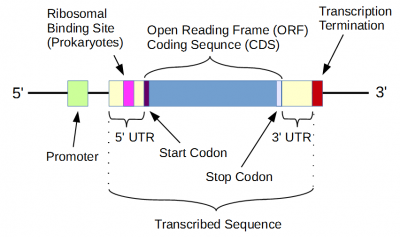Difference between revisions of "Gene"
(→Protein Coding Genes) |
|||
| Line 11: | Line 11: | ||
=Common Examples= | =Common Examples= | ||
==Protein Coding Genes== | ==Protein Coding Genes== | ||
| − | Many genes code for a polypeptide protein sequence that has enzymatic activities required to carry out the metabolic functions of a cell.<ref>However, it should be pointed out that most gene products function to regulate gene expression rather than carry out chemical modifications on, and conversions between, metabolic substrates.</ref> This type of gene is the one in mind with the classical central dogma of genetics: DNA is transcribed to RNA is translated to Protein. | + | Many genes code for a polypeptide protein sequence that has enzymatic activities required to carry out the metabolic functions of a cell.<ref>However, it should be pointed out that most gene products function to regulate gene expression rather than carry out chemical modifications on, and conversions between, metabolic substrates.</ref> This type of gene is the one in mind with the classical central dogma of genetics: DNA is transcribed to RNA which is translated to Protein. |
| − | These genes have a promotor, a ribosomal binding sequence, 3' and 5' untranslated regions, a start and stop codon and at least one exon. Many of these genes also contain introns that are spliced out during RNA processing. The resulting RNA product is a messenger RNA (mRNA) that is translated by the Ribosome and tRNAs into the encoded protein. | + | [[File:Gene-protein-coding.png|400px]] |
| + | |||
| + | These genes have a promotor, a ribosomal binding sequence, 3' and 5' untranslated regions, a start and stop codon and at least one exon. Many of these genes also contain introns that are spliced out during RNA processing. The resulting RNA product is a messenger RNA (mRNA) that is translated by the Ribosome and tRNAs into the encoded protein. | ||
==Non-Coding RNA== | ==Non-Coding RNA== | ||
Revision as of 01:15, 12 July 2014
A gene is defined as a functional unit of genetic inheritance that is located at a physical position on a chromosome and ultimately contributes to a phenotype.
Contents
Misconceptions
- Genes do not have to be organized into discrete units along a strand of DNA. Functionally different genes can overlap.
- Genes do not always code for a polypeptide (protein) sequence. Many genes code for RNA sequences with their own function distinct from protein coding mRNA.
- There is confusion between the definitions of genes and alleles. Alleles are versions of genes. There is not a gene for red hair or blue eyes in people. There are alleles of genes that can result in red hair or blue eyes (in the right genotype configuration).
Generalities
Genes have a promoter that initiates transcription of the DNA sequence by an RNA polymerase into an RNA sequence.
Common Examples
Protein Coding Genes
Many genes code for a polypeptide protein sequence that has enzymatic activities required to carry out the metabolic functions of a cell.[1] This type of gene is the one in mind with the classical central dogma of genetics: DNA is transcribed to RNA which is translated to Protein.
These genes have a promotor, a ribosomal binding sequence, 3' and 5' untranslated regions, a start and stop codon and at least one exon. Many of these genes also contain introns that are spliced out during RNA processing. The resulting RNA product is a messenger RNA (mRNA) that is translated by the Ribosome and tRNAs into the encoded protein.
Non-Coding RNA
Many genes are transcribed into RNA and the RNA itself carries out a function in the cell. RNAs are required to assemble the Ribosome (rRNAs) and transfer-RNAs (tRNAs) that work with mRNA to carry out translation of the RNA sequence into a protein polypeptide. RNA can have catalytic properties like proteins. RNA also has a large role to play in gene expression regulation.
Exceptions
- In the case of RNA virus genome, genes do not exist as DNA but are RNA sequences.
- It is difficult to precisely define the physical boundaries of a gene. Sequences that affect expression can sometimes be found at a long distance away or even on different chromosomes.
References and Footnotes
- ↑ However, it should be pointed out that most gene products function to regulate gene expression rather than carry out chemical modifications on, and conversions between, metabolic substrates.
